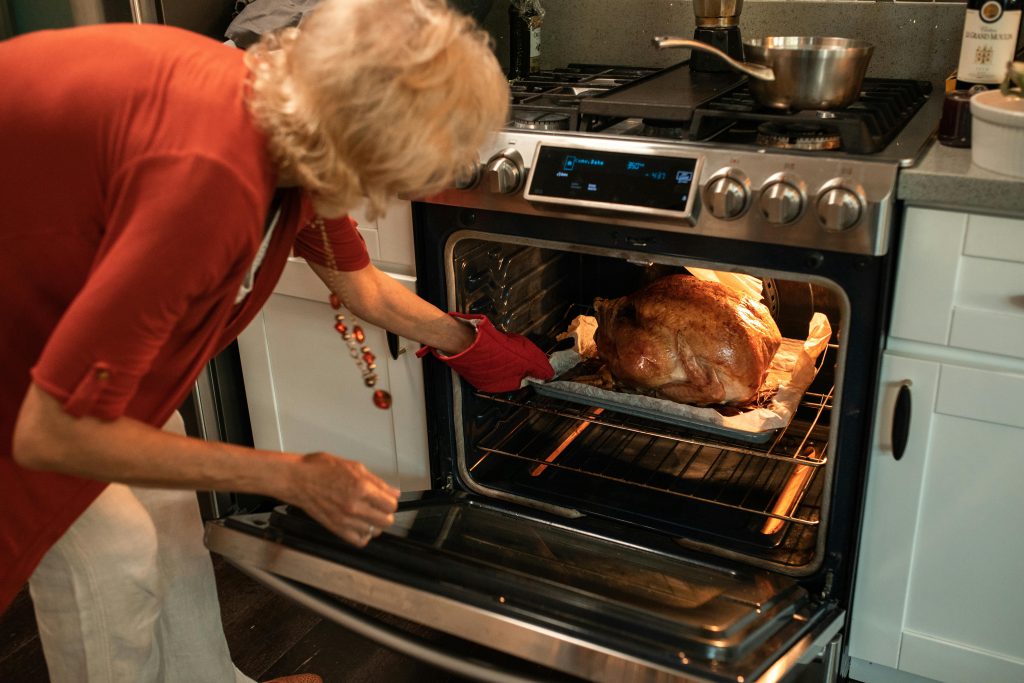All fields are required
Posted in Food Safety,Our Blog on November 23, 2024

We have arrived at the day where 46 million turkeys are cooked and eaten for Thanksgiving. 46 million. That’s a huge number and honestly more than I thought. A whopping 88% of Americans will consume turkey on Thanksgiving. Not sure what the other 12% eat but we have seen some ideas that include ham, brisket, and even a cheeseburger. In our home, we are very traditional for Thanksgiving and love serving turkey and all of the fixings.
Today, we will talk about safely cooking a turkey which includes when to take it out to thaw down to carving. I have prepared the bird for our family for over a decade now and feel that I could do it in my sleep, but there are so many people who each year step up to the plate (no pun intended) to prepare the prized Thanksgiving meal.
Starting with thawing (unless you have a fresh bird), this is one of the most important parts of safely cooking a turkey.
The USDA recommends thawing your turkey in the refrigerator. This is the safest method because the turkey will thaw at a consistent, safe temperature. This method takes some time, so allow one day for each 4 – 5 pounds of weight. If your turkey weighs 16 pounds, it will take about four days to thaw. Once thawed, the turkey is safe for another two days, so you can start thawing it six days before thanksgiving (the Friday before Thanksgiving).
The other two methods (cold water and microwave) must be done immediately before you start cooking the turkey, so you’ll have to wait until Thanksgiving morning.
For the cold water method, leave the turkey in its original wrapping and submerge it in a sink (or container) full of cold water. It is important that the water be cold so that the turkey stays at a safe temperature. You should change the water every 30 minutes. Empty out the water and replace it with fresh cold water. With this method, allow 30 minutes of defrosting time per pound, so a 16 pound turkey will take 8 hours to thaw using this method (so you might need to start around 4 a.m. if you want to eat in the afternoon!). Once the turkey has thawed, cook it immediately
Before you commit to thawing your turkey in the microwave, check your owner’s manual for the size turkey that will fit in your microwave oven, the minutes per pound and the power level to use when thawing a turkey. Remove all outside wrapping and place the turkey on a microwave-safe dish to catch any juices that may leak. Use the defrost function based on weight. As a general rule, allow 6 minutes per pound when thawing a turkey in the microwave. Be sure to rotate it several times, and even flip it, during the thawing process.
If the turkey starts to actually cook instead of just defrost, let it rest for 5 minutes or so before you resume thawing. Partway through thawing you may wish to cover the tips of the wings and drumsticks with a small piece of foil to shield them from the microwaves and keep them from cooking. Once the turkey has thawed you should cook it immediately.
In case you are wondering, here are some thawing methods that are not recommended:
Raw turkey and its juice can contaminate anything they touch. Be sure to handle your turkey correctly to prevent harmful germs from spreading to other food or your family and friends.
It’s safest to cook stuffing in a casserole dish instead of inside your turkey. Cooking stuffing in a casserole dish makes it easier to know the stuffing is thoroughly cooked. Stuffing inside the turkey won’t get up to the right internal temperature to kill bacteria – yuck!
To roast a turkey in your oven, set the oven temperature to at least 325°F. Place the completely thawed turkey in a roasting pan that is 2 to 2-1/2 inches deep. Cooking times depend on the weight of the turkey and whether it is stuffed.
Use a food thermometer to make sure your turkey has reached a safe internal temperature of 165°F. Check by inserting a food thermometer into three places, avoiding bone: thickest part of the breast; where body and thigh join, aiming toward thigh; and where body and wing join, aiming toward wing. Even if your turkey has a pop-up timer, you should still use a food thermometer to check that it is safely cooked.
When stored in the refrigerator, turkey does not last as long. Snyder points to the USDA FoodKeeper app for best guidance: The tool notes that refrigerated, cooked turkey should be eaten within 4 days. Eat frozen turkey leftovers within 6 months for premier quality.
The Centers for Disease Control and Prevention says that your leftover turkey should be sliced or divided into small quantities and stored within 2 hours. This allows for the leftovers to cool quickly and evenly in the refrigerator and freezer.
Be aware of any signs that your turkey is past its prime. “Consumers can tell leftover turkey has spoiled by using their senses,” says Snyder. “Refrigerated turkey leftovers that have spoiled may be slimy or have a bad smell.”
If the turkey has been stored in the freezer, you will be able to tell if it is no longer safe to eat if it is discolored, tough, or dry.
For more holiday food safety tips please follow Make Food Safe.